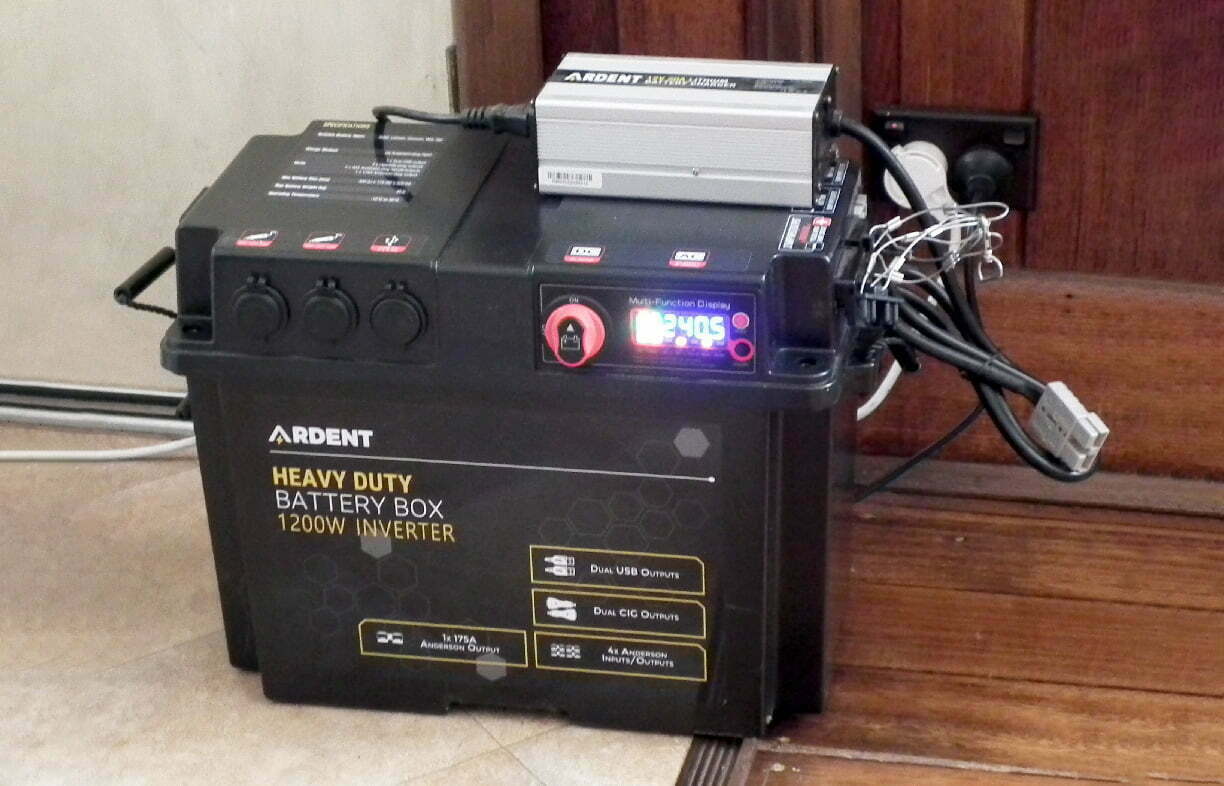Deleting the genset

If you have the need for the occasional use of a generator, then why not replace it with a much cleaner battery backup system instead? Lance Turner explains how.
Living in semi-rural Tasmania, we have become used to power blackouts whenever we get storms. It’s common for tree branches to take out power lines around here, and blackouts can last several hours—our longest one so far was 17 hours.
Not only is it inconvenient, but when you work from home and run your own online businesses, you need power pretty much all the time. We are also further at the mercy of the power gods here as we are on bore water and so need electricity for our mains pressure pump (our main water system uses a bore pump to fill a 6000 litre tank, so we always have plenty of water, but to get it to the house requires a pressure pump). Also for other loads, such as the fridge, lighting, etc, we needed a simple, reliable backup without the expense of a fixed battery system and the associated installation costs.
The options
I looked around to see what might suit, and the first thought was a decent sized computer UPS (uninterruptible power supply). However, such units are really designed for short-term use and nearly all come with sealed lead-acid batteries and have quite small energy storage capacities. Further, because they charge their batteries continuously, UPSes waste a fair bit of energy.
There are UPS systems with extendable storage using add-on battery modules, but they are quite expensive per kilowatt-hour of storage and were simply not good economically.
Another option I considered was the portable “generator replacement” systems, such as the Bluetti units, which are design for the sort of use I had in mind, and include a battery, inverter, charger and various power outlets, all in a compact, portable unit. They are very nice, but most have quite small capacities, and the higher capacity units were quite expensive.
My next option was to put together a simple power backup system myself. However, it needed to be portable, so the low-cost sealed lead-acid batteries were out as they are just too heavy to be lugging around for any decent amount of capacity. I also wanted to do something that was simple and could be easily replicated by almost anyone.
I looked around and ran across the Atlas Lithium battery range at Aussie Batteries and Solar (aussiebatteries.com.au). These are self-contained lithium iron phosphate batteries which have in-built battery management systems (BMS) that limit charge and discharge currents and voltages to safe levels for the battery cells. In effect, they are pretty much foolproof, and are designed to allow you to use them in place of similarly sized lead-acid batteries. Even better, they are Australian made and also sold under a couple of other brands by Smart Battery Technologies (smartbatterytechnologies.com.au).
Unlike lead-acid batteries, LFP batteries can be fully cycled (discharged to close to 0% state of charge) with minimal loss of capacity. Lead-acid batteries suffer considerable loss of cycle life if you regularly discharge them too far.
Also, LFP batteries are fire resistant, unlike the more flammable lithium chemistries that have been bursting into flames in cheap e-transport devices (and even some commercially-made domestic storage systems!). This means they are generally safe to store and use indoors.
Of course, a bare battery isn’t much use as it needs to be fitted to an enclosure, and if you want to power anything other than a 12 V DC load, you will need either an inverter (for 230 V AC mains power loads) or DC-DC converters for charging phones and other low power DC loads.
I looked around at standard battery boxes, and came to the conclusion that the cheap ones were simply not worth it. Fortunately, Aussie Batteries also stock Ardent battery boxes, so I decided to get the whole system from there. My system consisted of:
- A 12.8 V, 175 Ah (2.24 kWh) Atlas Lithium LFP battery with BMS: $799 (pricing varies, but they are often discounted)
- An Ardent Heavy Duty Battery Box with 1200 W sinewave inverter. This box also has an inbuilt voltage and power meter, battery isolator switch, dual 12 V cigarette lighter sockets, dual USB outputs, four 50 A Anderson sockets for charging, battery linking and power, and a 175 A Anderson output for high output power use. The box also has thermal, overload and short circuit protection as well as battery low voltage shutdown: $499
- An Ardent 12 V, 20 A lithium battery charger with Anderson plug: $199.
So, the total was around $1497, which is quite good compared to the prebuilt units. I also paid around $150 shipping because being in Tasmania has its drawbacks!
Putting it together
There isn’t a lot to assembling such a system. You open up the battery box and remove the accessories like the tie-down strap etc, drop the battery in place, and attach the battery leads to the battery terminals, making sure the battery box isolator is in the off position, and fit the plastic terminal covers to the terminals.
Once the battery is in, you fit the lid and screw it into place with the four allen key screws supplied and you’re done.
The box has a rope handle at each end to make moving the battery box easier—it’s a great deal lighter than a lead-acid battery based system, with the 175 Ah battery only weighing around 15 kg.
Charging is simply a matter of turning on the battery isolator to connect the Anderson sockets to the battery, plugging the charger into one of the 50 A Anderson sockets and plugging the charger into the mains. The battery charges to around 14.2 V and you’re done.
When not on charge, the battery will only discharge a few percent per month (with the isolator off), and so only needs the occasional recharge to keep ready for the next blackout.

How to use it
When the power goes down, you simply turn on the battery isolator switch on the battery box. The inverter will start, ready for any load up to 1200 W continuous. There is a single 230 V outlet on the battery box, but you can of course plug in a power board for more loads. Obviously, if you load up the inverter fully, you are going to flatten the battery in less than two hours, but a typical modern energy-efficient fridge will run from this battery for more than a day.
Other loads, like phones and laptops will probably run for up to a week or more on a battery of this size. Even a good sized desktop computer will run all day on such a system. On this system there is a pushbutton switch that turns the inverter and associated display on and off, allowing you to eliminate the inverter’s idle power if you are not using the 230 V outlet.
It should be noted that the BMS in the battery has a maximum discharge current limit. If you exceed this, the BMS will disconnect the output until the load is removed. So, if your battery has, for example, a 100 A output limit, don’t connect some honking big load to the 175 A Anderson connector as you will probably trip the BMS protection. There are “double BMS” versions of these batteries, which means they have twice the output rating of the standard version.
Another useful aspect of these battery boxes is that you can link multiple units together in parallel for more energy storage by connecting them via the Anderson connectors using appropriate cables. In theory, you could connect three or four of these units together to make a battery bank approaching 10 kWh.
You can also charge these batteries using a 12 V solar panel and suitable charge controller.
Not just backup
The system described here is basically the core of any independent system. As such, these boxed battery systems can be used for all sorts of off-grid uses, such as shed and barn lighting and power, generator replacement for camping, or anywhere you need DC or AC power where it isn’t normally available.
Further reading
 Efficient homes
Efficient homes
Building for a changing climate
Are we building homes for the future, or for the past? Rob McLeod investigates how climate change is impacting home energy ratings and the way we build our homes.
Read more Efficient homes
Efficient homes
Gas and our health
Dr Ben Ewald uncovers the health effects of gas in the home.
Read more

